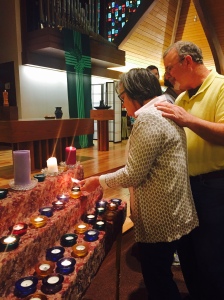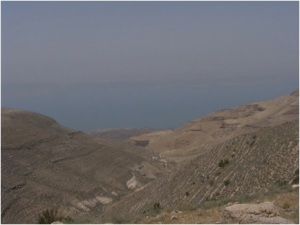A sermon preached at Southminster Presbyterian in Boise, ID on October 25, 2014.
Deut 34
This weekend is when we remember the Protestant Reformation. Almost 500 years ago, Martin Luther posted some complaints about the medieval church on Twitter.
No, on his Facebook page.
No, that’s not quite right either.
He wrote them down on a piece of paper (how medieval!) and nailed them to the door of the cathedral at Wittenberg (or that’s the story….). And so, each year, we recognize our place in the schism of the Body of Christ.
Don’t get me wrong. I’m proud to be Presbyterian. I’m proud to come from the Reformed tradition of the faith.
Yet I acknowledge the divisions in the body of Christ, within our own tradition and denomination, and I pause to pray for unity. Surely we can do better.
Tonight we are also celebrating All Saints Day, which is actually next week, on November 1. All Saints is an ancient celebration of the Christian faith, even as some traditions interpret it differently.
And to understand the difference, we go back to the Reformation. In the Roman Catholic tradition, “saint” is a title commonly conferred on particular people in whom the church has seen particular holiness or faithfulness. There are ancient saints, like Patrick and Francis. There are more contemporary saints too, like Pope John Paul 2, canonized in 2014.
In the Reformed Tradition, saints are all of us, living or dead. Saints are merely people who have been made holy, or sanctified, by God.
The apostle Paul greets people in his letters as saints. He wasn’t writing to dead people. He was writing to people in Corinth who couldn’t get along. He was writing to people in Galatia who were unsure who should be leading their church. He was writing to you and me.
And so we recognize All Saints’ Day, not to worship or venerate the people who have died, but to acknowledge their place, our place in the journey.
Later in the service, when you come forward for communion, you will be invited to pause and light a candle in memory of people who have died. It is a sacred reminder to lift up the memory of those who have journeyed ahead of us into the Promised Land.
I think of Jim Moore, one of the earliest pastors of this church, who passed away this spring. It is a privilege to follow in his footsteps as pastor of this congregation. I think about Frances Grantham, and Don and Jean Barkell, Bud Keyt and others who passed away in the past few years.
Whether they were members here just a few years or whether they built this particular building, we follow in the steps of those who have gone before us. And we are grateful for their witness in our lives.
So light a candle and remember.
Remember the grandmother who took you to Sunday school.
Remember the neighbor lady who provided a house of refuge when you needed it.
Remember the saints who taught you Sunday School and who comforted you when Christopher Rieken cut your hair with blunt scissors when he should have been paying attention to the flannel board Jesus lesson. (I promise. I’ve let it go. Christopher is one of the saints too. Grateful I knew him.)
Remember the saints who showed you God’s love in the form of a casserole or a plate of brownies.
Remember the saint who spoke a difficult truth to you and led you to a place of deeper faith.
Remember.
Remember.
Remember.
The truth is we didn’t always know the people we are remembering.
Many of the people who built this sanctuary had died before I got here 6 years ago, but I am thankful for their faithfulness, their good taste in architecture, and the love that built these walls.
The truth is that these saints didn’t know all of us either. When they built this sanctuary, they didn’t know who would be at Southminster in 2014.
And still they built, and labored, and created this place where we gather, where we worship, where we are equipped to go out into the world to serve the saints of God.
It is such a gift to build something for people you don’t even know. Sometimes the work of being a saint, of being someone made holy and sanctified by God, is hard and thankless work.
I’ve shared this story before. A few years ago, I heard a story on the radio about a man named AP Tureaud, who in the days of school integration, was the first and only African American student at LSU. He was miserable. His professors wouldn’t touch his papers. The people who roomed next to him made a campaign to make him leave, playing music all night long and making noise so he couldn’t sleep. One day, on campus, a pick up truck drove up to him and an African American man in workers overalls got out of the truck and asked him if he was AP Tureaud.
“Yes”.
The man went back to his truck and brought out his seven year old son and said, “I want my son to meet you because I want him to know that this is possible for him, to come to this school, thanks to you.”
In that moment, despite the misery he was living in, AP Tureaud knew what it meant to see the Promised Land. At 17 years old, by being a symbol of integration, he understood that good things were going to come out of the painful experiences he was enduring. He had seen the Promised Land.
Moses knew that too.
He knew the 40 year-long road to the Promised Land was not easy. It wasn’t a walk through the park. It was people complaining in the wilderness that he had brought them there to die.
It was disobedience.
It was being bitten by snakes.
It was knowing that you were wandering and not moving forward.
It was eating manna, manna, more manna, and quails.
And then God takes him to Mt Nebo, which is in modern day Jordan.
And from there he can look down across the Jordan hillside, across the giant river and over to what is today Southern Israel.
That was all I could see, at least, when I was in the Middle East.
But according to the text, Moses had better vision. God showed him the land from the south to the north of Israel, a panoramic sweep of the land for each of the tribes.
What is it like, do you think? To be so close that you can see what you’ve wanted for your whole life?
And to know that you aren’t going to make the rest of the journey?
Because of the Hebrew people’s disobedience, and Moses failure as a leader to obey, the original generation of Hebrew people who left Israel died before they reached the promised land. It was only the next generation who made it across the river. The first generation, other than Caleb and Joshua, died in the wilderness. Granted, it is still better than dying in slavery, but they never crossed over to the Promised Land.
But they didn’t stop when they knew that justice was out of reach for them. They kept on the journey to make a better future for their children.
And the Promised Land sometimes seems like it is so far away that it isn’t even worth the trouble of heading that direction. It can be hard to seek the Promised Land when the milk and honey will be flowing for someone else.
But Moses kept on leading the people toward a goal he knew he would never reach.
And so I suspect that as Moses looked across the river, and saw the land God had promised to his ancestors, that God had led them out of slavery for, and must have felt some relief. Some sense of, “we made it. Even if I won’t get there with them, I see the path clearly now. It will be okay.”
This week, I invite you to attend to what it means to be a saint. If you want to go the Mother Theresa route, that’s fine.
Or you can be like me, a flawed and very human person who is grateful that God’s love filters into our messy lives and makes us sacred agents for God’s goodness and mercy.
How has your life been blessed by the saints who have come before you?
What are you participating in now that is leading people toward a Promised Land you might not ever see?
For all the saints who from their labors rest, we give thanks.
For all the saints who journeyed in the wilderness to get us to this Promised Land, we give thanks.
For all of you saints, who love and feed other people’s children (like mine!) and who have built within these walls a place where people can learn of God’s love, we give thanks.
For the privilege of being one of the saints, working to build a beautiful city we may not fully get to live in, we give thanks.
Earlier, we heard Beautiful City from Godspell.
We may not reach the ending
But we can start
Slowly but truly mending
Brick by brick, heart by heart
So, go be saints. Brick by brick, heart by heart, step by step, we’ll build God’s beautiful city and journey together to the Promised Land.





Very moving. “For all the saints” was one my mother’s favorite hymns (it was one of the runners up when she chose the music for her funeral). Remembering her and many other saints at the moment.
LikeLike
Celebrating her and all those who from their labors rest.
LikeLike
Pingback: Wide River to Cross | Glass Overflowing